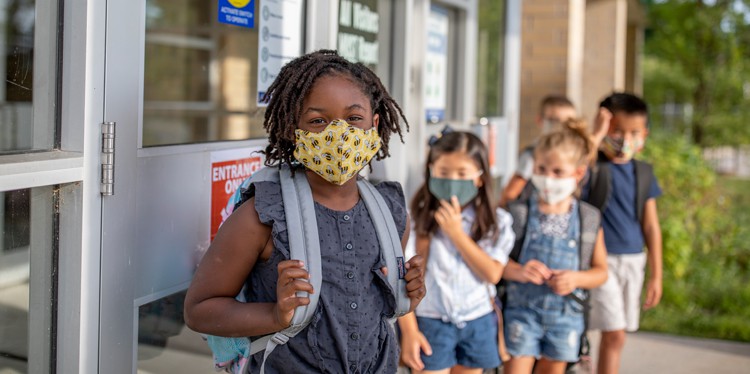Back to school and back to extracurricular activities

It’s early September and that means it’s time for back to school and also back to extracurricular activities. Many parents often wonder – which activities are the best for my child? How many activities are enough? Or too many? This year, with the ongoing COVID-19 pandemic, there is the added concern of how to stay safe both at school and at after-school activities. After so much social isolation and disruption of routines during this past school year, we may be eager to return to “normal” busy schedules. Our forced downtime of the past year offers an opportunity to be thoughtful about how to incorporate activities for our children and teenagers.
When it comes to choosing activities, there is no “one size fits all” approach. It is important to take into account your own child or teen’s interests, needs, and temperament. We know that there are social and developmental benefits for kids and teens to participate in extracurricular activities, but as with anything, there needs to be a balance.
A schedule that is too jam-packed can be stressful for the whole family. Teens especially can feel the pressure of a busy schedule and can have increased stress or mental health struggles. For young athletes, there are special considerations in terms of injury prevention and making sure they experience positive coaching. Sometimes parents get overly focused on having their child excel at a single sport, but this can put young athletes at risk for overuse injuries.
Kids and teens also need unstructured downtime for rest, play, and time with family. And they need time for sleep. For younger kids ages 6-12 years old, they need 9-12 hours per night. And teens need on average about 9 hours per night.
The best guide for these decisions is going to be your own child or teen – how are they doing? Are they energized by their activities or are they exhausted by an overly full schedule? Are they withdrawn or spending excessive time on screens and devices and would benefit from some added structure? Or are they content to have quiet downtime and seem to be doing well with fewer activities?
For many of the families I care for, these questions are not their primary worries. We must continue to support policies that support working parents and families with fewer resources, as well as work to create safe neighborhoods where opportunities for unstructured play and restful downtime are a reality for kids and teens.
With the rise of the COVID-19 Delta variant coinciding with children and teens returning to school, at the forefront of my mind as a pediatrician is keeping kids as safe as possible as they return to school and activities. Masking and physical distancing continue to be important tools to mitigate infection risk, but the absolute best way to be protected from COVID-19 is to get vaccinated. Everyone age 12 and older is eligible to receive a COVID-19 vaccine. For young children aged 11 and under, who are not yet eligible to be vaccinated, the best way to protect them is to vaccinate all eligible adults and older children around them.
If you or your child or teen have not received your COVID-19 vaccine, I encourage you to call today to schedule an appointment. For children and teens ages 12-17, the only approved COVID-19 vaccine is the Pfizer vaccine which is available at Hennepin Healthcare Clinic and Specialty Center, Whittier, Brooklyn Park, and Richfield Clinics. Call 612-873-6963 to schedule a vaccine appointment or schedule online.
Hennepin Healthcare also offers a unique Vaccine Mobile program that can come to your home; this service is available to families who live within 20 miles of Hennepin Healthcare’s downtown campus. You can call 612-430-2251 to connect with a Vaccine Mobile team member.
Another important consideration for kids and teens returning to athletic activities is to make sure to schedule a pre-participation sports physical. This year there are added screening requirements for anyone who has recovered from COVID-19 infection. If you have any questions or concerns about your athlete starting back to sports, please call your child or teen’s healthcare provider.
During sports and other activities, make sure to follow masking and physical distancing guidelines. See additional links below for information from the Minnesota Department of Health and the American Academy of Pediatrics about sports participation during COVID-19.
- Healthychildren.org – American Academy of Pediatrics Encourages Organized Sports
- Healthychildren.org – How to Help Children Build Resilience in Uncertain Times
- Healthychildren.org – The Power of Play – How Fun and Games Help Children Thrive
- Healthychildren.org – Youth Sports: A COVID-19 Safety Checklist
- Minnesota Department of Health – COVID-19 Organized Sports Recommendations
About the author
 Jane Harris, MD is a general pediatrician in Hennepin Healthcare’s Department of Pediatrics. She enjoys seeing patients at the downtown Clinic and Specialty Center as well as via telemedicine. Dr. Harris enjoys the inherently holistic and preventive nature of pediatric medicine. Originally from Seattle, WA, she moved to Minnesota for medical school. She completed both her medical degree and residency training at the University of Minnesota. She lives with her husband and daughter in Minneapolis. She is accepting new patients.
Jane Harris, MD is a general pediatrician in Hennepin Healthcare’s Department of Pediatrics. She enjoys seeing patients at the downtown Clinic and Specialty Center as well as via telemedicine. Dr. Harris enjoys the inherently holistic and preventive nature of pediatric medicine. Originally from Seattle, WA, she moved to Minnesota for medical school. She completed both her medical degree and residency training at the University of Minnesota. She lives with her husband and daughter in Minneapolis. She is accepting new patients.

